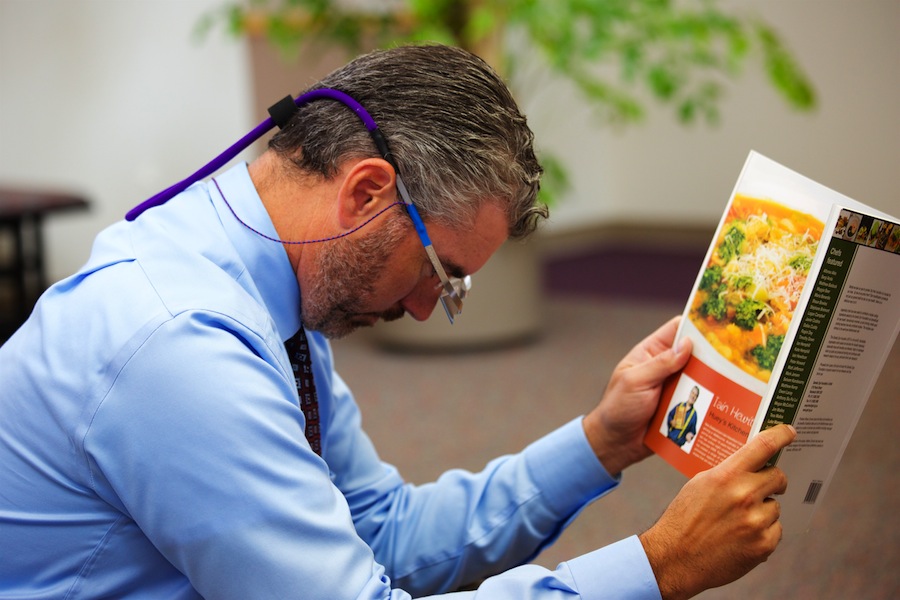
Mirror-rimmed spectacles provide improved comfort, function for patients after retinal surgery
Mirror-rimmed spectacles — glasses adapted at the UC Davis Eye Center — allow a person to see their surroundings while lying in a face down position.
Glenn Yiu, an assistant professor of ophthalmology at UC Davis, published a pilot study in the online journal Retina, in which he tested these glasses on patients one week after retinal surgery. It was found that the new design of glasses significantly improved visual function and quality of life compared to using a mirror to see one’s surroundings.
After retinal eye surgery, it is necessary for patients to recover in a head down position for about a week. This is to help reattach the damaged structures in the eye and achieve the optimal effect of the surgery.
“We rent the glasses one to two weeks at a time with a hold deposit of $20,” said a certified optician at the UC Davis optical shop who preferred to remain anonymous. “It’s something patients can use after an eye surgery that requires them to have their head faced downward.”
The mirror-rimmed spectacles change the direction of light by bending it to a certain angle. The glasses have a set of prisms that have a mirror at the base, so a person in a head down position is able to see their surroundings.
The study reported that patients used the glasses for 51 percent of the hours they were awake and 90 percent reported excellent comfort while wearing them.
The retina is an extremely thin, light sensitive structure that lines the inside of the eyeball, similar to how wallpaper lines surfaces. This layer of tissue sends visual signals to the brain, however, it is possible for the retina to tear or become detached from the eyewall.
“If the retina is detaching and moving away from focal point of light, an individual perceives vision with a curtain of shadow that can impede vision,” said professor Paul FitzGerald of the UC Davis Department of Cell Biology and Anatomy.
Other symptoms of retinal detachment include seeing flashes of light and an increase in floaters, which are little specks that travel across an individual’s field of vision caused by tiny pieces of cellular debris moving about.
Older individuals are more prone to retinal tears and detachments compared to younger people.
“As you get older the fluid [in the eye] begins to break up, and there is a process of gel turning into liquid,” FitzGerald said. “With the occurrence of a retinal tear, that fluid can leak through and build up behind the retina.”
Retinal detachment can also cause consequences to the anatomy of the eye. The main issue is with the light sensory cells contained within the eye, specifically the rods and cones. Rods and cones are the most metabolically active cells in the body, requiring a high energy demand and need for much oxygen and nutrients to survive.
If a retinal detaches or tears, the rods and cones are displaced and not able to access enough nutrients and oxygen. Death of these cells can lead to vision loss.
However, eye surgeries such as laser, cryopexy or freeze treatment can help stop small tears or holes in the retina.
The most common surgery is gas injection, in which an eye doctor injects a gas bubble into the eye to help hold the retina against the eyewall so it can be properly treated and heal correctly. Gas is used because it is lighter than fluid and can float inside the eye.
“If a person sits upright after the surgery, the gas bubble inserted won’t be positioned appropriately, and it is less likely the retina will reattach and reduces the success of the surgery,” Yiu said.
The mirror-rimmed spectacles were adapted for this very reason and help patients cope with the recovery position.
Another potential application of these glasses regarding health is use by patients who receive Magnetic Resonance Imaging.
This diagnostic technique allows scientists to take images of the soft tissue and bones of the body, but in order to do so, a patient must lie in the very confined space of the machine.
For claustrophobic patients, wearing mirror-rimmed spectacles allows them to see out and around the machine so they feel more comfortable.
Glasses, called “belayer glasses,” are spectacles of the same principal idea that exist to aid rock climbers. Belayers, the people who hold the ropes steady and assist in holding the weight of the climber, have to be constantly looking up.
Belay glasses, which change the angle of light, relieve neck strain by allowing the person to keep their neck straight yet have vision of what is above them.
“The awareness of prism use to change direction of light is not new in application, but I wanted to discover if it works from a patient standpoint,” Yiu said.
The goal of the study was to see if the glasses could improve the comfort of patients who were healing after retinal surgery.
“One of the measurements used for this study was the National Eye Institute Visual Functioning Questionnaire,” Yiu said. “It showed improved quality of life of patients who used the glasses compared to those who used mirrors and support props to manage resting face down.”
The glasses adapted and tested at the UC Davis Eye Center have a wide range of application use and though use of physics and light optics; individuals are able to see their surroundings without directly looking at it.
Written by: Shivani Kamal — science@theaggie.org



